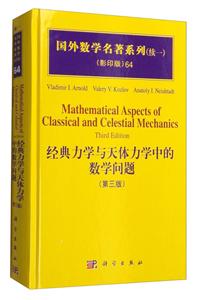经典力学与天体力学中的数学问题

|
经典力学与天体力学中的数学问题作者:Vladimir 开 本:16开 书号ISBN:9787030235077 定价:198.0 出版时间:2016-03-23 出版社:科学出版社 |
经典力学与天体力学中的数学问题 内容简介
This work describes the fundamental principles, problems, and methods of classical mechanics. The main attention is devoted to the mathematical side of the subject. The authors have endeavored to give an exposition stressing the working apparatus of classical mechanics. The book is significantly expanded compared to the previous edition. The authors have added two chapters on the variational principles and methods of classical mechanics as well as on tensor invariants of equations of dynamics. Moreover, various other sections have been revised, added or expanded. The main purpose of the book is to acquaint the reader with classical mechanics as a whole, in both its classical and its contemporary aspects.
经典力学与天体力学中的数学问题 目录
1 Basic Principles of Classical Mechanics1.1 Newtonian Mechanics
1.1.1 Space, Time, Motion
1.1.2 Newton-Laplace Principle of Determinacy
1.1.3 Principle of Relativity
1.1.4 Principle of Relativity and Forces of Inertia
1.1.5 Basic Dynamical Quantities. Conservation Laws
1.2 Lagrangian Mechanics
1.2.1 Preliminary Remarks
1.2.2 Variations and Extremals
1.2.3 Lagrange's Equations
1.2.4 Poincare's Equations
1.2.5 Motion with Constraints
1.3 Hamiltonian Mechanics
1.3.1 Symplectic Structures and Hamilton's Equations
1.3.2 Generating Functions
1.3.3 Symplectic Structure of the Cotangent Bundle
1.3.4 The Problem of n Point Vortices
1.3.5 Action in the Phase Space
1.3.6 Integral Invariant
1.3.7 Applications to Dynamics of Ideal Fluid
1.4 Vakonomic Mechanics
1.4.1 Lagrange's Problem
1.4.2 Vakonomic Mechanics
1.4.3 Principle of Determinacy
1.4.4 Hamilton's Equations in Redundant Coordinates ...
1.5 Hamiltonian Formalism with Constraints
1.5.1 Dirac's Problem
1.5.2 Duality
1.6 Realization of Constraints
1.6.1 Various Methods of Realization of Constraints
1.6.2 Holonomic Constraints
1.6.3 Anisotropic Friction
1.6.4 Adjoint Masses
1.6.5 Adjoint Masses and Anisotropic Friction
1.6.6 Small Masses
2 The n-Body Problem
2.1 The Two-Body Problem
2.1.1 Orbits
2.1.2 AnomMies
2.1.3 Collisions and Regularization
2.1.4 Geometry of Kepler's Problem
2.2 Collisions and Regularization
2.2.1 Necessary Condition for Stability
2.2.2 Simultaneous Collisions
2.2.3 Binary Collisions
2.2.4 Singularities of Solutions of the n-Body Problem
2.3 Particular Solutions
2.3.1 Central Configurations
2.3.2 Homographic Solutions
2.3.3 Effective Potential and Relative Equilibria
2.3.4 Periodic Solutions in the Case of Bodies of Equal Masses
2.4 Final Motions in the Three-Body Problem
2.4.1 Classification of the Final Motions According to Chazy.
2.4.2 Symmetry of the Past and Future ~.
2.5 Restricted Three-Body Problem
2.5.1 Equations of Motion. The Jacobi Integral
2.5.2 Relative Equilibria and Hill Regions
2.5.3 Hill's Problem
2.6 Ergodic Theorems of Celestial Mechanics
2.6.1 Stability in the Sense of Poisson
2.6.2 Probability of Capture
2.7 Dynamics in Spaces of Constant Curvature
2.7.1 GenerMized Bertrand Problem
2.7.2 Kepler's Laws
2.7.3 Celestial Mechanics in Spaces of Constant Curvature
2.7.4 Potential Theory in Spaces of Constant Curvature
3 Symmetry Groups and Order Reduction
3.1 Symmetries and Linear Integrals
3.1.1 NSther's Theorem
3.1.2 Symmetries in Non-Holonomic Mechanics
3.1.3 Symmetries in Vakonomic Mechanics
3.1.4 Symmetries in Hamiltonian Mechanics
3.2 Reduction of Systems with Symmetries
3.2.1 Order Reduction (Lagrangian Aspect)
3.2.2 Order Reduction (Hamiltonian Aspect)
3.2.3 Examples: Free Rotation of a Rigid Body and the Three-Body Problem
3.3 Relative Equilibria and Bifurcation of Integral Manifolds
3.3.1 Relative Equilibria and Effective Potential
3.3.2 Integral Manifolds, Regions of Possible Motion, and Bifurcation Sets
3.3.3 The Bifurcation Set in the Planar Three-Body Problem
3.3.4 Bifurcation Sets and Integral Manifolds in theProblem of Rotation of a Heavy Rigid Body with a Fixed Point
自然科学 力学
在线阅读
- 最新内容
- 相关内容
- 网友推荐
- 图文推荐
| [高考] 2022 西安电子科技大学《软件工程》大作业答案 (2022-04-25) |
| [家长教育] 孩子为什么会和父母感情疏离? (2019-07-14) |
| [教师分享] 给远方姐姐的一封信 (2018-11-07) |
| [教师分享] 伸缩门 (2018-11-07) |
| [教师分享] 回家乡 (2018-11-07) |
| [教师分享] 是风味也是人间 (2018-11-07) |
| [教师分享] 一句格言的启示 (2018-11-07) |
| [教师分享] 无规矩不成方圆 (2018-11-07) |
| [教师分享] 第十届全国教育名家论坛有感(二) (2018-11-07) |
| [教师分享] 贪玩的小狗 (2018-11-07) |






